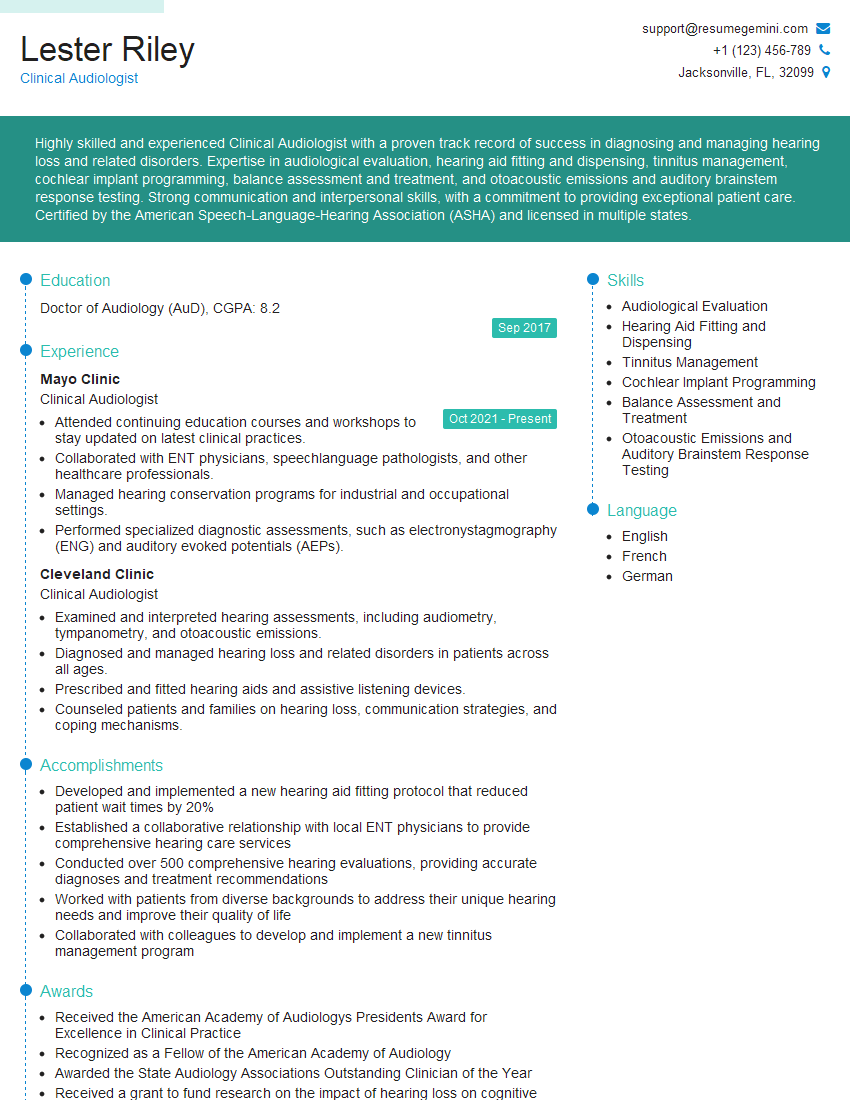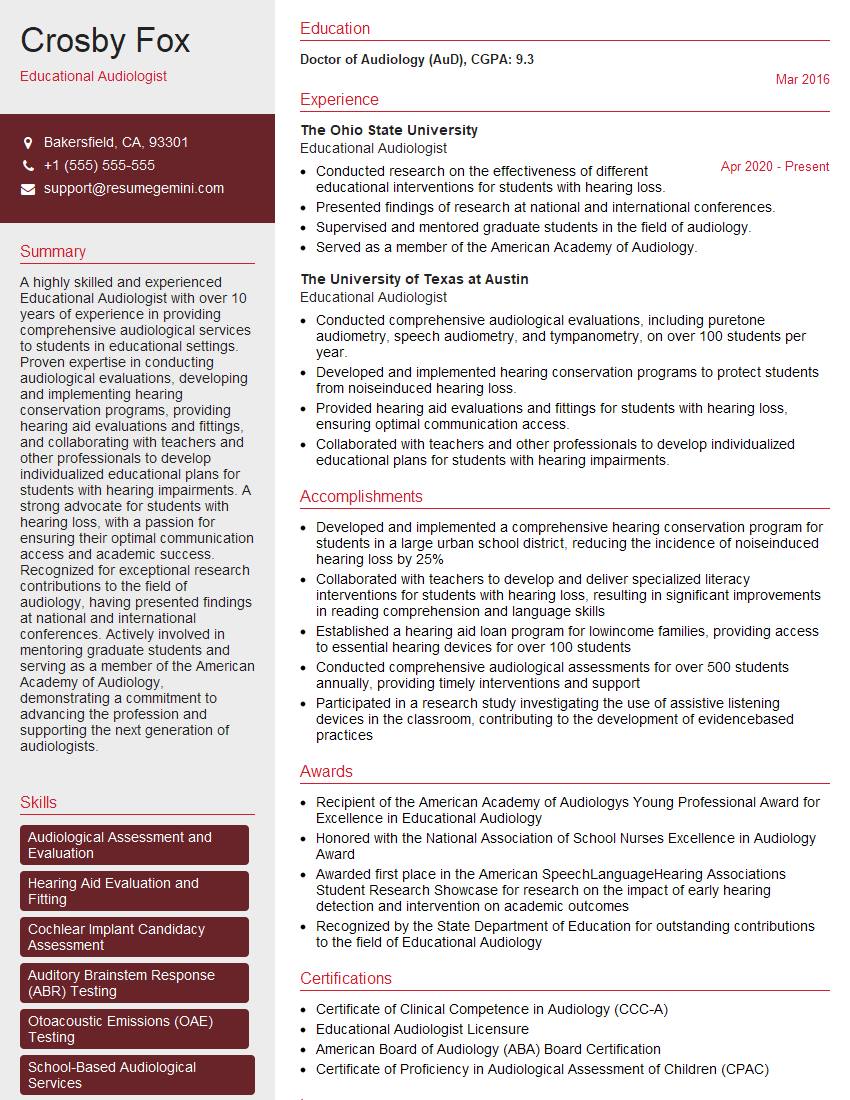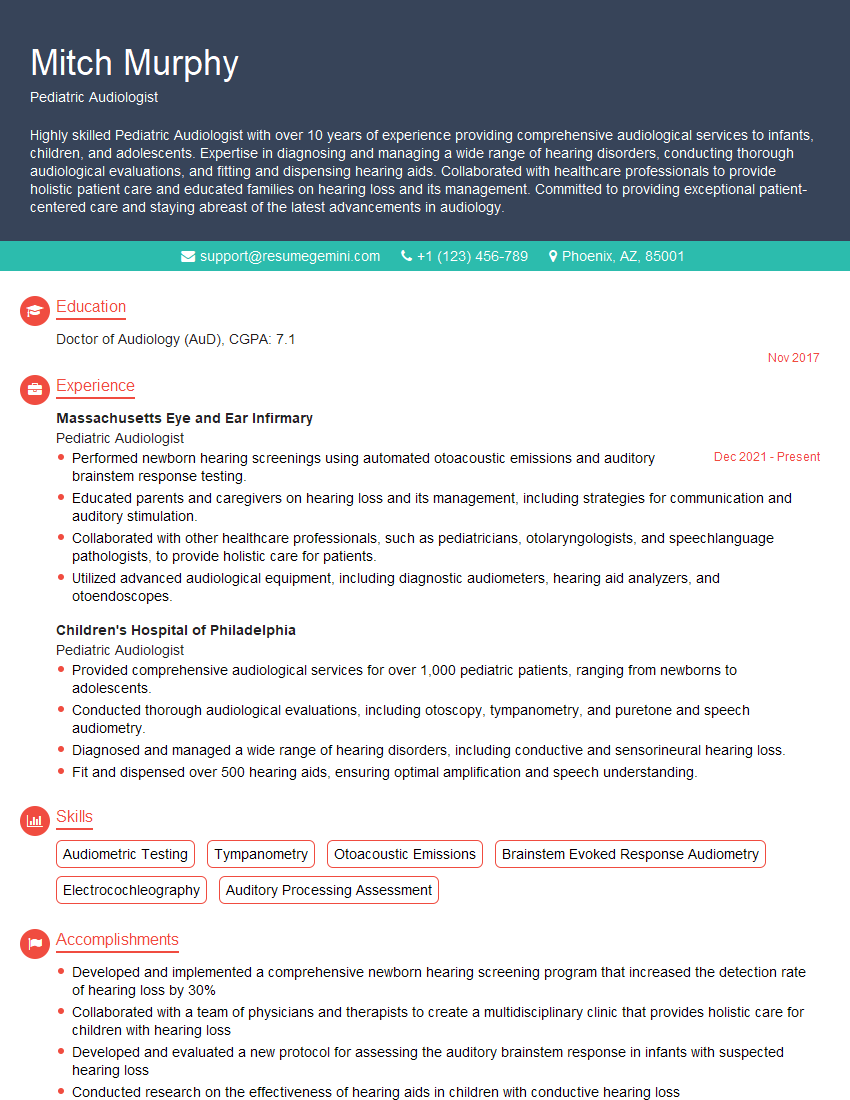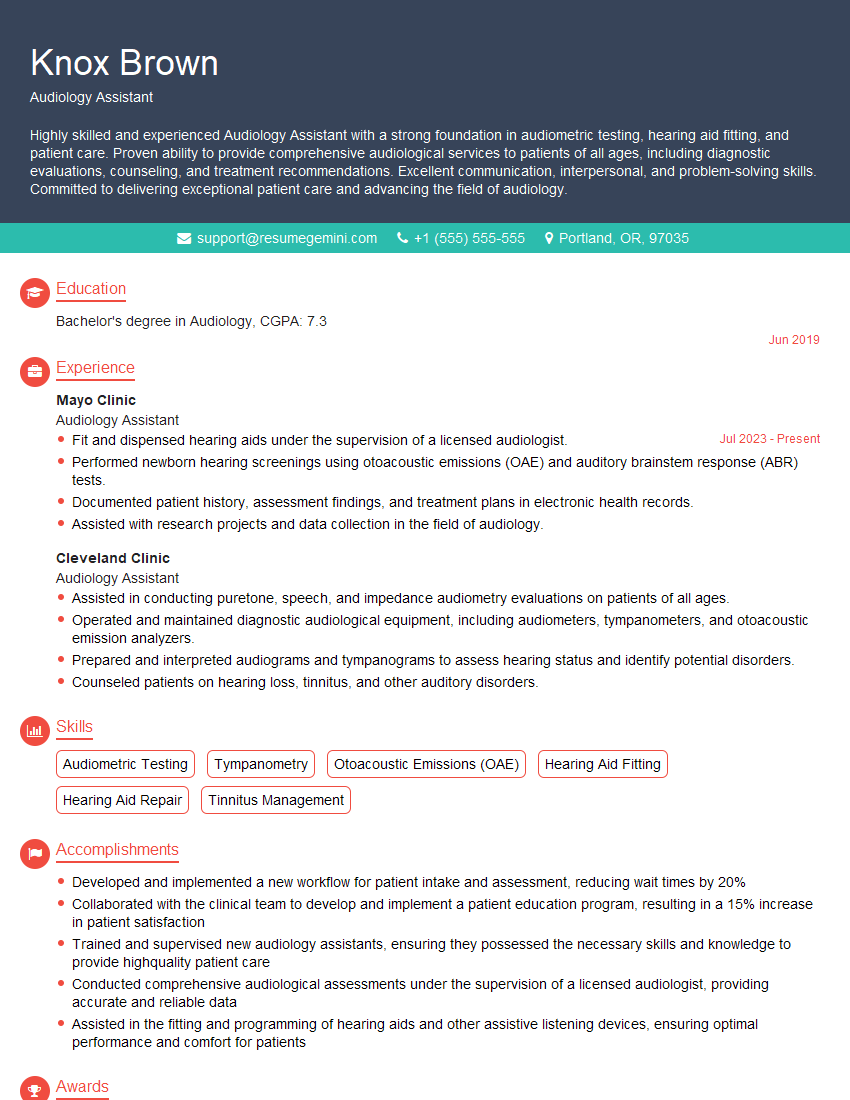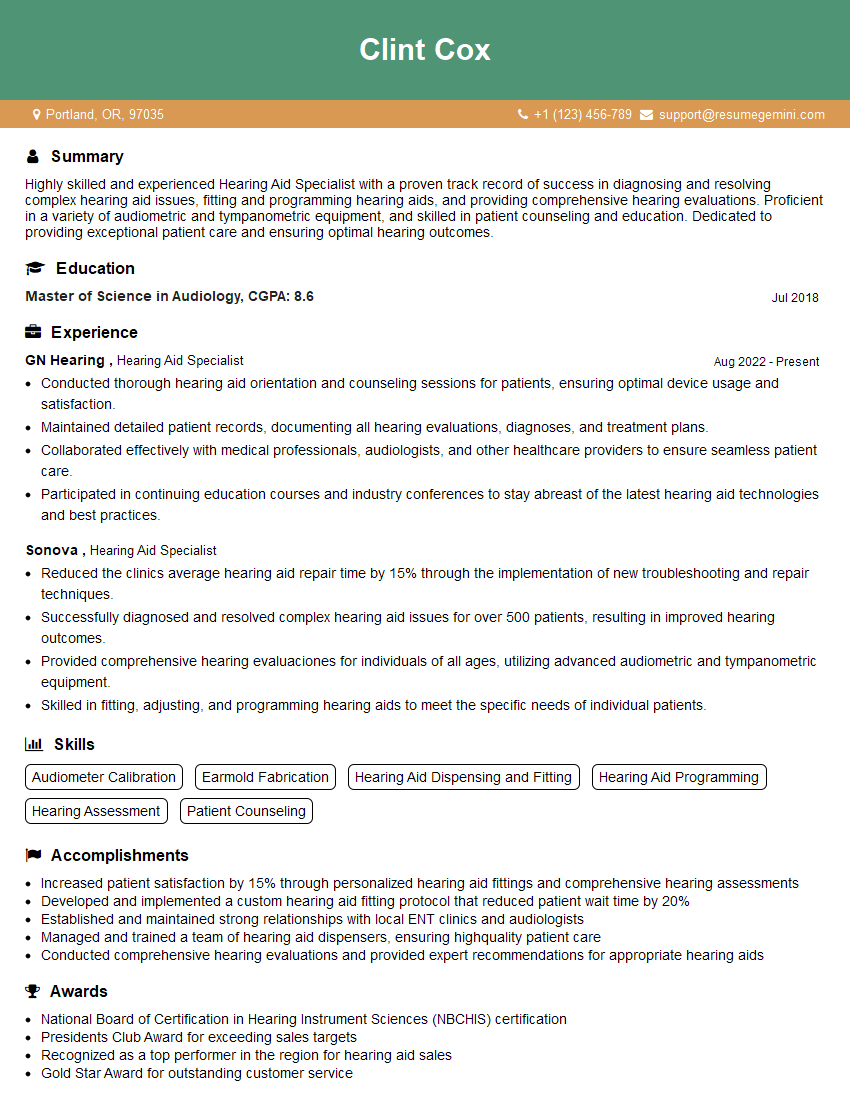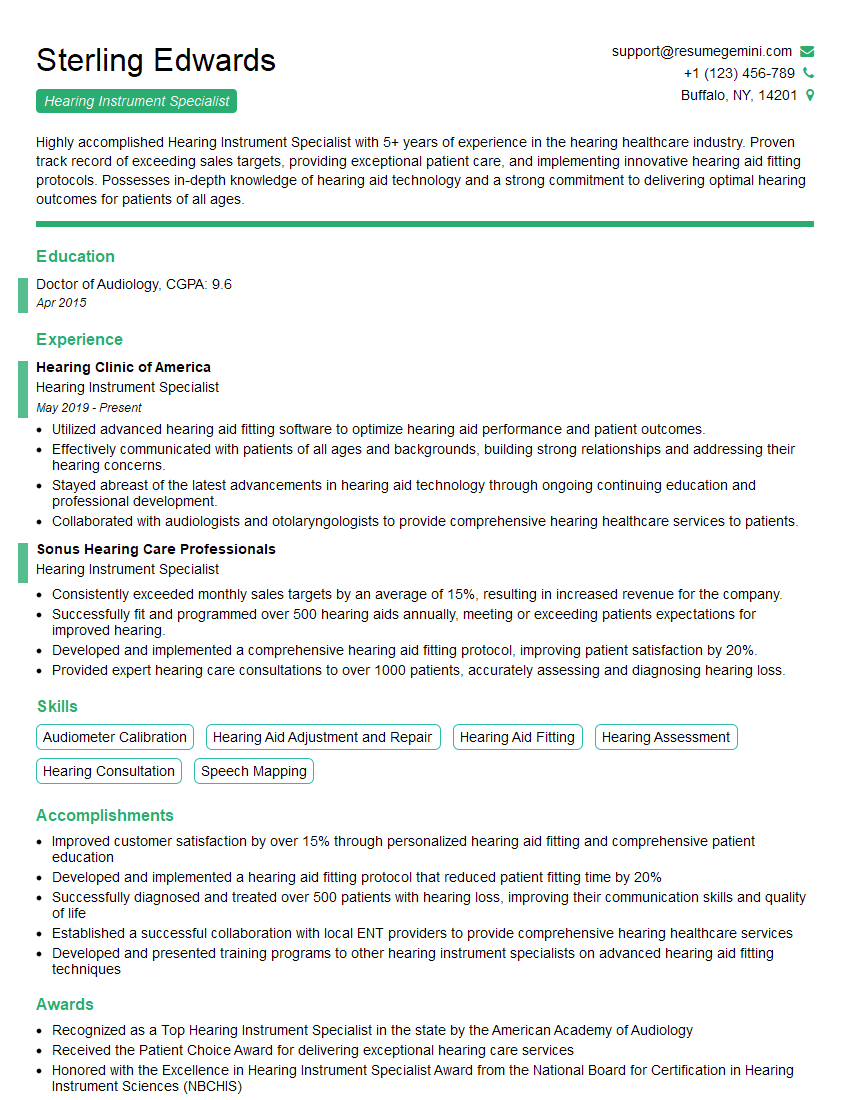Interviews are more than just a Q&A session—they’re a chance to prove your worth. This blog dives into essential Hearing Screening interview questions and expert tips to help you align your answers with what hiring managers are looking for. Start preparing to shine!
Questions Asked in Hearing Screening Interview
Q 1. Explain the difference between pure-tone audiometry and speech audiometry.
Pure-tone audiometry and speech audiometry are both crucial components of comprehensive hearing assessments, but they measure different aspects of hearing function. Pure-tone audiometry objectively measures the threshold of hearing at different frequencies using pure tones (single frequencies). Think of it like testing individual keys on a piano to see which ones you can hear at the softest volume. It provides a detailed frequency-specific profile of hearing sensitivity. Speech audiometry, on the other hand, assesses how well a person understands speech in various listening conditions. It’s more about how well the brain processes and interprets sounds that make up speech, not just detecting their presence. This is like listening to a song; you need to understand both the individual notes (frequencies) and how they blend together to form meaningful words and sentences.
Q 2. Describe the procedure for performing a basic hearing screening using pure-tone audiometry.
A basic hearing screening using pure-tone audiometry typically involves the following steps:
- Patient Preparation: Ensure the patient understands the instructions and is comfortable. Explain the process clearly.
- Headphone Placement: Properly place the headphones (supra-aural or insert) to ensure a good seal to prevent sound leakage.
- Tone Presentation: Present pure tones (usually starting at 1000 Hz) at varying intensities (decibels, dB HL). Start above the expected threshold and gradually decrease the intensity.
- Response Recording: Record the patient’s response (hand raise or button press) for each tone presented. If a response is given at a certain decibel level, it is considered the threshold for that frequency.
- Frequency Range: Test key frequencies (typically 250, 500, 1000, 2000, 4000 Hz) in both ears.
- Repeat Testing: Repeat the test at least once to ensure accuracy and consistency.
- Documentation: Document the results on an audiogram, charting the hearing thresholds for each frequency in each ear.
For example, if a patient consistently responds to 1000 Hz tone at 25 dB HL, we record that as their hearing threshold at that frequency.
Q 3. What are the common types of hearing loss, and how are they identified during screening?
Common types of hearing loss identified during screening include:
- Conductive Hearing Loss: This occurs when sound is not conducted effectively through the outer or middle ear. Think of it like a blockage in a pipe preventing water flow. It’s often temporary and treatable. During screening, this might manifest as a generally lower threshold across all frequencies, more so for lower frequencies.
- Sensorineural Hearing Loss: This involves damage to the inner ear (cochlea) or the auditory nerve. This is like damage to the speaker itself. It’s frequently permanent. The audiogram might show significant loss in specific frequency ranges or across all frequencies. This can be due to noise exposure, aging, or disease.
- Mixed Hearing Loss: This combines elements of both conductive and sensorineural hearing loss. The audiogram will show a pattern reflecting both types of loss.
The screening identifies these types of hearing loss based on the pattern of thresholds obtained on the audiogram. A flat loss across frequencies suggests sensorineural loss, while a sloping loss with relatively better high-frequency hearing may suggest conductive loss.
Q 4. What are the indications for referral after a hearing screening?
Several factors warrant referral after a hearing screening:
- Significant Hearing Loss: A threshold of 25 dB HL or greater at any frequency in either ear indicates the need for comprehensive audiological evaluation.
- Unilateral Hearing Loss: Significant loss in one ear only, even if the other ear has normal hearing.
- Asymmetrical Hearing Loss: Significant difference in hearing thresholds between the two ears.
- Abnormal Audiometric Findings: Any unusual pattern or configuration of hearing loss not easily attributable to a single cause.
- Patient Concerns: Reports of hearing difficulties despite normal screening results.
Early detection and intervention are crucial, so even mild findings prompting patient concern necessitate referral for further investigation.
Q 5. How do you interpret a hearing screening result showing a significant hearing loss in one ear?
A significant hearing loss in one ear (unilateral hearing loss), even if the other ear is normal, requires a referral to a qualified audiologist. The interpretation focuses on identifying the cause and determining its impact on communication, localization, and sound clarity. This situation could indicate several possibilities:
- Middle Ear Problem: A blockage or infection in one ear.
- Inner Ear Damage: Sensorineural hearing loss affecting only one ear, possibly due to noise trauma, inner ear infection, or other factors.
- Auditory Nerve Issue: A neurological problem impacting the transmission of sound signals to the brain.
Further testing, such as acoustic reflexes, tympanometry, and potentially MRI or CT scans, is necessary to determine the precise cause and appropriate management plan.
Q 6. What are the limitations of a basic hearing screening?
Basic hearing screenings have several limitations:
- Limited Frequency Range: Typically focuses on a few key frequencies, potentially missing subtle or high-frequency hearing loss.
- Lack of Detailed Information: Doesn’t provide the same level of detail as a full audiological evaluation, including speech testing and other diagnostic procedures.
- Potential for False Negatives/Positives: Patient factors like inattention or environmental noise can affect results.
- Doesn’t Diagnose the Cause: Only identifies the presence and type of hearing loss but doesn’t pinpoint the underlying cause.
Therefore, a positive screening result should be followed by a thorough audiological evaluation to confirm the findings and determine the underlying cause and treatment.
Q 7. Explain the importance of proper patient positioning and instruction during hearing screening.
Proper patient positioning and instruction are paramount to accurate hearing screening. Positioning involves ensuring the patient is seated comfortably, facing the audiometer, and maintaining minimal background noise. This minimizes distractions and ensures they are optimally positioned to receive the test signals accurately. Clear instructions are equally crucial. Before initiating the test, explain clearly what will be happening, what the patient should do when they hear a tone (e.g., raise a hand or press a button), and what to expect during the procedure. The patient should understand that it’s important to indicate when they hear a sound, even if they’re unsure.
For example, a child undergoing screening might need more interactive instructions and playful encouragement compared to an adult. A patient with cognitive impairment might need simplified explanations and demonstrations.
Q 8. How do you handle a patient who is uncooperative during a hearing screening?
Managing an uncooperative patient during a hearing screening requires patience, understanding, and a flexible approach. It’s crucial to remember that the patient’s behavior may stem from anxiety, discomfort, hearing impairment itself, or other underlying factors. I begin by establishing rapport, explaining the procedure in simple terms, and addressing any concerns they might have. I might use positive reinforcement, offering praise for cooperation, or try different techniques to gain their attention, like using engaging toys or pictures for younger children or employing a calm, reassuring voice for adults. If the patient remains uncooperative, I may need to reschedule the screening to a time when they are more relaxed or seek assistance from a colleague or guardian. In some cases, involving the patient’s physician or a psychologist could provide valuable insight into the underlying cause of their uncooperativeness and inform a better strategy.
For example, I once worked with a young child who was initially very reluctant to participate in the hearing screening. By using colorful headphones and a playful approach, engaging them in a “game” of listening for sounds, I was able to successfully complete the test. Flexibility is key; sometimes, even shortening the testing time or offering breaks can significantly improve cooperation.
Q 9. Describe the appropriate use of different types of audiometers.
Audiometers are essential tools for measuring hearing sensitivity. Different types are used depending on the specific needs of the test and the patient’s condition. Pure-tone audiometers are the most common, used to assess hearing thresholds at various frequencies. These are crucial for identifying the type and degree of hearing loss. Speech audiometers present speech stimuli, allowing us to measure speech reception thresholds (SRT) and speech discrimination scores. This helps understand how well a person understands speech, even if their hearing is impaired. There are also specialized audiometers for specific applications, such as those used for evoked potential tests that assess auditory function indirectly by measuring brainwave responses to sounds.
For instance, a pure-tone audiometer would be used to determine if a patient has a hearing loss at specific frequencies, while a speech audiometer would be used to measure how well they understand spoken words against a background of noise. The choice of audiometer always depends on the clinical questions we are trying to answer during the assessment.
Q 10. How do you ensure accurate calibration of audiometric equipment?
Accurate calibration of audiometric equipment is paramount for reliable results. This is done regularly using a calibrated sound level meter and attenuator to verify the output of the audiometer at each frequency. We also check the integrity of the headphones and insert earphones using acoustic calibrators. These devices generate known sound levels to confirm the accuracy of the audiometer’s output. Calibration procedures should follow the manufacturer’s instructions and should be documented meticulously, including date, time, and results. Regular calibration ensures that the results obtained are accurate and comparable across different testing sessions and clinics. Failure to do so could lead to misdiagnosis and inappropriate management of a patient’s hearing problems. Calibration is a cornerstone of responsible audiological practice.
For example, a daily calibration check is often performed before beginning any testing. If any discrepancies are found, the audiometer should be sent for professional servicing before resuming testing.
Q 11. What are the common causes of conductive hearing loss?
Conductive hearing loss occurs when sound waves have difficulty traveling from the outer ear to the inner ear. This is typically due to problems in the outer or middle ear. Common causes include:
- Outer ear infections (otitis externa): Inflammation or infection of the ear canal can obstruct sound transmission.
- Middle ear infections (otitis media): Fluid buildup behind the eardrum impairs the ossicles’ ability to transmit sound vibrations.
- Cerumen impaction: Excessive earwax buildup can block the ear canal.
- Otosclerosis: Abnormal bone growth in the middle ear, causing stiffness and reduced sound transmission.
- Foreign bodies: Objects lodged in the ear canal.
- Perforated eardrum: A hole in the eardrum can disrupt sound conduction.
Imagine it like trying to play a drum with a pillow over it – the sound is muffled and reduced. Conductive hearing loss is often treatable, often with medication or surgical intervention.
Q 12. What are the common causes of sensorineural hearing loss?
Sensorineural hearing loss results from damage to the inner ear (cochlea) or the auditory nerve. This is often permanent and irreversible. Common causes include:
- Age-related hearing loss (presbycusis): Gradual hearing loss associated with aging.
- Noise-induced hearing loss (NIHL): Exposure to loud noises over time damages hair cells in the cochlea.
- Genetic factors: Hereditary conditions can predispose individuals to hearing loss.
- Ototoxic medications: Certain medications, like some antibiotics and chemotherapy drugs, can damage the inner ear.
- Infections: Viral or bacterial infections, such as meningitis or mumps, can cause inner ear damage.
- Head trauma: Injuries to the head can disrupt the function of the inner ear or auditory nerve.
Think of it as the microphone in your inner ear becoming damaged or the wires connecting it to your brain being severed; you can’t hear the sound as well.
Q 13. What are the different types of hearing aids, and how are they selected?
Hearing aids are designed to amplify sound and improve hearing. The selection process is personalized, based on the individual’s hearing loss, lifestyle, and preferences. There are several types:
- Behind-the-ear (BTE): A device worn behind the ear, with a tube connecting to an earmold.
- In-the-ear (ITE): A device that fits entirely within the outer ear.
- In-the-canal (ITC): A smaller device that fits within the ear canal.
- Completely-in-canal (CIC): A very small device that is completely hidden inside the ear canal.
- Bone conduction hearing aids: These devices transmit sound vibrations through the bone to the inner ear. Used for conductive and mixed hearing loss, or in situations where the outer or middle ear is not functioning properly.
Selection involves a comprehensive hearing evaluation, including determining the type and degree of hearing loss. A hearing aid specialist then considers factors such as the patient’s ear anatomy, lifestyle needs (e.g., need for noise reduction in noisy environments), dexterity, and budget to recommend the most appropriate type and model of hearing aid. Trial periods and adjustments are common parts of the process to ensure optimal fit and performance.
Q 14. Explain the concept of air-bone gap and its significance.
The air-bone gap refers to the difference in hearing thresholds measured by air conduction (AC) and bone conduction (BC) audiometry. Air conduction tests measure hearing through the outer and middle ear, while bone conduction bypasses these structures and directly stimulates the inner ear. A significant air-bone gap (typically 15 dB or more) indicates a conductive component to the hearing loss. This means that sound is not traveling efficiently through the outer or middle ear, impacting sound transmission before it reaches the inner ear.
Imagine a leaky pipe carrying water to your house. Air conduction is like the pipe, while bone conduction is like directly pouring the water into the house. If the pipe is leaky, there’s less water arriving (hearing loss), and the difference between how much water is delivered directly and via the pipe is significant. This significant difference between AC and BC highlights the presence of a conductive component, which may stem from middle ear issues such as fluid build-up, or other causes of conductive hearing loss as discussed earlier.
Q 15. What are the common challenges in conducting hearing screenings on infants and young children?
Screening infants and young children for hearing loss presents unique challenges. Their inability to follow instructions or verbalize their experiences necessitates reliance on behavioral observation and objective measures. For example, while older children might respond to a tone by pointing, infants require sophisticated techniques.
- Limited Attention Span: Young children have short attention spans, making it difficult to maintain their focus during the test. We often need to use engaging toys or games to keep them occupied and cooperative.
- Behavioral Difficulties: Crying, fussiness, and movement artifacts can interfere with accurate test results. Strategies like calming techniques and shorter testing sessions are vital.
- Middle Ear Infections: Infants and toddlers are prone to middle ear infections (otitis media), which can temporarily mask hearing loss and lead to false-negative results. Repeated screenings might be needed.
- Technological Limitations: Some hearing screening techniques, like conventional audiometry, are unsuitable for infants. Instead, we use specialized methods like Auditory Brainstem Response (ABR) testing or Otoacoustic Emissions (OAE) testing, which are objective and less dependent on the child’s cooperation.
Imagine trying to conduct a hearing test on a six-month-old who is only interested in their toes! Adapting to their developmental stage is crucial for successful screening.
Career Expert Tips:
- Ace those interviews! Prepare effectively by reviewing the Top 50 Most Common Interview Questions on ResumeGemini.
- Navigate your job search with confidence! Explore a wide range of Career Tips on ResumeGemini. Learn about common challenges and recommendations to overcome them.
- Craft the perfect resume! Master the Art of Resume Writing with ResumeGemini’s guide. Showcase your unique qualifications and achievements effectively.
- Don’t miss out on holiday savings! Build your dream resume with ResumeGemini’s ATS optimized templates.
Q 16. How do you adapt your approach for individuals with cognitive impairments during a screening?
Adapting the hearing screening approach for individuals with cognitive impairments requires patience, understanding, and a flexible methodology. The goal is to find ways to assess hearing regardless of the individual’s cognitive abilities.
- Simplified Instructions: Instead of complex verbal instructions, we use simple gestures, visual cues, and demonstrations. For example, pointing towards a sound source.
- Behavioral Observation: We carefully observe the patient’s responses to sound stimuli, including eye movements, head turns, and startle reflexes, even if they cannot verbally communicate their hearing.
- Modified Test Procedures: We might shorten the test duration, adjust the intensity of the sounds, or use different types of stimuli to elicit a response. For instance, using familiar sounds like a rattle or a toy.
- Collaboration with Caregivers: Input from caregivers is invaluable as they know the individual’s preferences, communication style, and potential limitations. This partnership is key to a successful screening.
For example, with a patient who understands simple commands but struggles with complex language, we might use a simple “yes/no” system with visual aids to determine their response to different sounds. The caregiver’s knowledge of the patient’s usual behavior forms a crucial benchmark.
Q 17. Describe the importance of maintaining accurate documentation in a hearing screening setting.
Accurate documentation is fundamental for providing high-quality hearing healthcare and ensuring continuity of care. Detailed records help track progression, inform treatment decisions, and maintain patient safety.
- Legal and Ethical Compliance: Accurate records protect both the patient and the clinician from potential legal issues, demonstrating adherence to professional standards.
- Effective Communication: Well-maintained records facilitate clear and concise communication between healthcare professionals involved in the patient’s care, improving care coordination.
- Tracking Progress: Documentation allows monitoring of hearing changes over time, enabling early identification of deterioration and timely intervention. For example, charting hearing thresholds from a previous test allows comparison and immediate identification of decline.
- Research and Quality Improvement: Aggregated data from accurate records contribute to research initiatives aimed at improving hearing healthcare practices.
Imagine a situation where a patient needs to see an audiologist in a different clinic. Without comprehensive documentation, the transfer of essential information would be difficult, potentially delaying or compromising effective treatment.
Q 18. What are the ethical considerations related to hearing screening and referral?
Ethical considerations in hearing screening and referral are paramount. They center on patient autonomy, beneficence, non-maleficence, and justice.
- Informed Consent: Patients must understand the purpose, procedure, and potential risks and benefits of hearing screening before providing consent. This includes the possibility of referral for further evaluation.
- Confidentiality: Patient information must be handled with utmost discretion, adhering to privacy regulations (e.g., HIPAA in the US). Sharing results with unauthorized individuals is unethical.
- Referral Process: Referrals should be made to qualified professionals who can provide appropriate diagnostic and management services. Unnecessary or inappropriate referrals should be avoided.
- Cultural Sensitivity: Healthcare professionals should be aware of and respectful of cultural differences that may influence a patient’s understanding of hearing loss and their willingness to seek treatment.
- Equity of Access: Efforts should be made to ensure equitable access to hearing screening and subsequent services for all populations, regardless of socioeconomic status or geographic location.
For example, ensuring that a patient who speaks only Spanish receives all information and consent forms translated accurately is critical for ethical practice.
Q 19. How do you explain complex hearing screening results to a patient in a clear and understandable manner?
Explaining complex hearing screening results requires clear, empathetic communication tailored to the patient’s understanding. Avoid jargon and use simple analogies.
- Use Lay Language: Avoid technical terms such as “audiogram” or “decibels” unless the patient demonstrates understanding. Instead, use phrases like “soft sounds” or “loud sounds”.
- Visual Aids: Diagrams or pictures can greatly assist in illustrating hearing thresholds and the types of sounds a person may struggle to hear.
- Real-World Examples: Relate hearing loss to everyday situations. For instance, “Imagine trying to hear a conversation in a crowded restaurant; this is the kind of difficulty you may experience.”
- Step-by-Step Explanation: Break down the results into manageable chunks and address any questions the patient has. Check for understanding at each step.
- Empathy and Patience: Acknowledge that receiving news about hearing loss can be emotional. Offer support and resources.
For example, instead of saying “Your audiogram shows a 40dB hearing loss at 1kHz,” say “You might have some trouble hearing normal conversational speech in quiet environments.”
Q 20. How do you ensure patient confidentiality during and after a hearing screening?
Maintaining patient confidentiality throughout the hearing screening process is essential. This involves adhering to strict protocols and ethical standards.
- HIPAA Compliance (or equivalent): Strictly adhere to relevant privacy regulations, ensuring patient data is securely stored, accessed, and transmitted only by authorized personnel.
- Secure Data Storage: Patient information should be stored in locked files or electronic systems with robust security measures (password protection, encryption).
- Limited Access: Only individuals directly involved in the patient’s care should have access to their records. Avoid discussing patient information in public areas.
- Patient Education: Inform patients of their rights concerning their health information and how their data will be handled. Obtain written consent for any disclosure.
- Data Disposal: Securely dispose of any patient records that are no longer required, adhering to established protocols.
For instance, all files should be password-protected, and discussion of patient results must occur only in private rooms to maintain confidentiality.
Q 21. Explain the role of hearing screening in early intervention programs.
Hearing screening plays a pivotal role in early intervention programs for hearing loss. Early detection is crucial for optimal development and outcome.
- Early Identification: Universal newborn hearing screenings identify infants with hearing loss early, allowing for immediate intervention. The earlier the intervention, the better the outcome.
- Intervention Services: Early intervention programs provide families with access to essential services, including audiological evaluations, hearing aids (if needed), speech-language therapy, and educational support.
- Improved Outcomes: Early intervention programs have been shown to significantly improve language development, academic achievement, and overall quality of life for children with hearing loss.
- Family Support: These programs also provide support and guidance to families, helping them cope with the diagnosis and navigate the intervention process.
- Long-Term Benefits: Early identification and intervention are associated with improved social-emotional development and reduced long-term educational and social challenges.
Imagine a child identified with hearing loss at six months old, receiving appropriate amplification and speech therapy. This early intervention can mean the difference between a child developing normal language skills and struggling with communication throughout their life.
Q 22. Describe the difference between a hearing screening and a comprehensive hearing evaluation.
A hearing screening is a brief, preliminary test used to identify individuals who may have a hearing loss. It’s like a quick check-up, aiming to flag potential problems needing further investigation. A comprehensive hearing evaluation, on the other hand, is a much more detailed assessment performed by an audiologist. This involves a series of tests to precisely determine the type, degree, and configuration of any hearing loss. Think of it as a thorough physical exam for your ears, providing a complete picture of your auditory system’s health.
For example, a hearing screening might use a simple pass/fail approach with pure-tone audiometry at a limited range of frequencies. A comprehensive evaluation, however, would employ pure-tone audiometry across a wider frequency range, speech audiometry, impedance audiometry, and possibly other advanced tests to pinpoint the exact nature of the hearing problem and recommend appropriate management.
Q 23. What are some common errors to avoid when performing a hearing screening?
Several errors can compromise the accuracy of a hearing screening. One common mistake is improper calibration of the equipment. This is crucial because inaccurate readings can lead to misdiagnosis. Another frequent error is failing to establish a rapport with the individual being screened, which can cause anxiety and affect test results. For instance, if a child is anxious, they may not respond reliably to the test tones. Inadequate environmental control – background noise can significantly interfere with accurate results – is another frequent issue. Finally, rushing through the screening without ensuring proper instructions and response from the patient can also lead to errors.
To avoid these errors, meticulous attention to equipment calibration is essential. Establishing trust and effective communication with the individual is equally vital. This involves using age-appropriate instructions and creating a relaxed testing environment. Minimising background noise is also crucial. Using sound-treated booths or conducting screenings in quiet areas greatly improves accuracy.
Q 24. How do you manage a situation where you suspect a medical emergency during a screening?
If I suspect a medical emergency during a hearing screening – for example, sudden hearing loss accompanied by dizziness or severe pain – my immediate priority is patient safety. I would immediately discontinue the screening and contact emergency medical services. Before contacting EMS, I would assess the patient’s condition, noting any vital signs, documenting my observations. Once EMS arrives, I would provide them with a concise report of my findings and observations. Patient confidentiality would be maintained, of course, while ensuring appropriate medical attention is received.
For instance, if a patient presents with sudden sensorineural hearing loss, accompanied by severe vertigo and nausea, this could indicate a serious condition like Meniere’s disease or a stroke, requiring immediate medical intervention. My role would shift from hearing screener to first responder, prioritizing the individual’s well-being.
Q 25. What are your strategies for maintaining effective communication with other healthcare professionals involved in hearing care?
Effective communication with other healthcare professionals is vital. I consistently use clear and concise documentation, detailing the screening results, observations, and any referral recommendations. I utilize standardized reporting methods to ensure consistency and clarity. I actively participate in team meetings and case conferences to collaborate on patient management. Furthermore, I leverage electronic health records (EHR) systems for seamless information sharing.
For instance, when referring a patient to an audiologist, I would provide a comprehensive report outlining the screening findings and my rationale for referral. This could include detailed notes on the patient’s responses, observations about their behavior, and any suspected underlying medical issues that could be relevant.
Q 26. How do you stay updated on the latest advancements in hearing screening technology and techniques?
Staying current in this rapidly evolving field requires proactive engagement. I regularly attend professional development workshops and conferences related to audiology and hearing healthcare. I subscribe to relevant journals and online resources, like the American Academy of Audiology publications, to stay informed about the latest research. Active participation in professional organizations also helps me connect with experts and access the latest information.
I also make it a point to attend webinars and online courses that focus on specific updates in technology or new screening protocols. Continuous learning ensures my skills and knowledge remain aligned with current best practices and technology advancements.
Q 27. Describe your experience with different types of hearing screening equipment.
My experience encompasses various hearing screening equipment, ranging from basic hand-held audiometers to automated screening systems. I am proficient in using different types of audiometers, including those that utilize pure-tone stimuli and those employing evoked otoacoustic emissions (OAE) testing. I’m comfortable using both traditional and contemporary techniques, adapting my approach based on the patient’s age and needs. I understand the strengths and limitations of each type of technology and the importance of choosing the most appropriate equipment for each situation.
For example, I’m experienced with using automated newborn hearing screening systems, which provide objective and rapid assessments for infants. I’m also familiar with using more sophisticated equipment for older children and adults that offer a wider range of testing options.
Q 28. Discuss the importance of universal newborn hearing screening.
Universal newborn hearing screening is crucial for early detection of hearing loss in infants. Early identification allows for timely intervention, significantly improving a child’s language development, cognitive skills, and overall quality of life. Untreated hearing loss can lead to significant delays in speech and language acquisition, impacting social and educational development. Early detection through newborn screenings allows for access to appropriate therapies and support, reducing the long-term effects of hearing impairment.
Imagine a child who is born with a hearing loss but receives early intervention. They will learn to speak and communicate effectively, much like their hearing peers. Without a newborn screening, this hearing loss may go undetected, leading to significant language delays and impacting their future opportunities. Early intervention is key to mitigating the negative consequences of hearing impairment.
Key Topics to Learn for Hearing Screening Interview
- Types of Hearing Loss: Understanding conductive, sensorineural, and mixed hearing loss; differentiating characteristics and implications for screening.
- Hearing Screening Tests and Procedures: Practical knowledge of pure-tone audiometry, otoacoustic emissions (OAE), and tympanometry; performing and interpreting test results.
- Interpreting Audiograms: Analyzing audiograms to identify different types and degrees of hearing loss; understanding thresholds and air-bone gaps.
- Patient Interaction and Communication: Effective communication strategies for explaining test procedures and results to patients of varying ages and understanding levels.
- Common Pediatric Hearing Screening Challenges: Addressing specific challenges in screening infants and young children; understanding developmental considerations.
- Hearing Screening Equipment and Technology: Familiarity with various audiometric equipment, calibration procedures, and troubleshooting common issues.
- Record Keeping and Documentation: Proper documentation of screening results, patient history, and follow-up recommendations; adhering to HIPAA regulations.
- Referral Pathways: Understanding when and how to refer patients to appropriate specialists (audiologists, ENT physicians) based on screening results.
- Legal and Ethical Considerations: Familiarity with relevant regulations and ethical guidelines related to hearing screening practices.
- Data Analysis and Reporting: Analyzing screening data to identify trends and patterns; preparing reports for relevant stakeholders.
Next Steps
Mastering hearing screening techniques opens doors to rewarding careers in healthcare, providing you with the skills to positively impact the lives of countless individuals. To maximize your job prospects, invest time in crafting a compelling and ATS-friendly resume that highlights your skills and experience. ResumeGemini is a trusted resource to help you build a professional resume that showcases your qualifications effectively. Examples of resumes tailored to Hearing Screening professionals are available to help guide you. Take the next step toward your dream career – create a resume that stands out!
Explore more articles
Users Rating of Our Blogs
Share Your Experience
We value your feedback! Please rate our content and share your thoughts (optional).
What Readers Say About Our Blog
Hi, I’m Jay, we have a few potential clients that are interested in your services, thought you might be a good fit. I’d love to talk about the details, when do you have time to talk?
Best,
Jay
Founder | CEO


